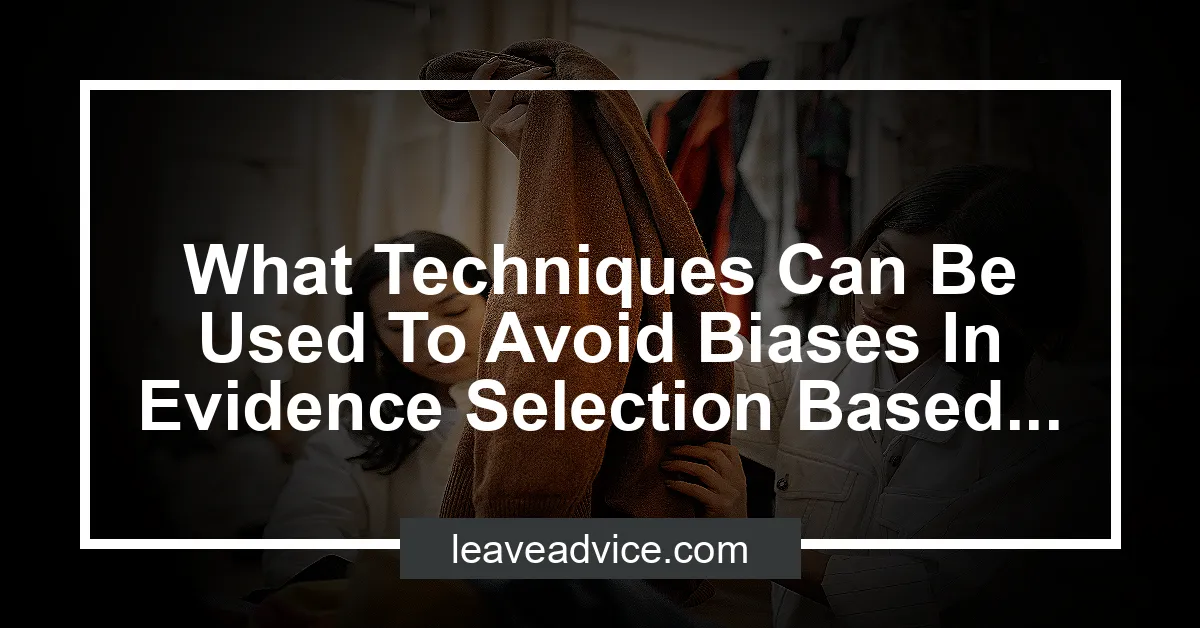What Techniques Can Be Used To Avoid Biases In Evidence Selection Based…


Defining Biases in Evidence Selection
Importance of Avoiding Biases in Evidence Selection
Check out this Youtube video: If you want to learn what techniques can be used to avoid biases in evidence selection, then this video is a must-watch!
Understanding the Root of Biases
Unconscious biases are deeply ingrained attitudes and stereotypes that influence our perceptions and decision-making without our awareness. They often stem from societal norms, cultural influences, and personal experiences, shaping our views in subtle yet powerful ways.
Unconscious Biases
Unconscious biases can manifest in various forms, such as gender bias, ageism, name bias, beauty bias, and the halo effect, influencing how we perceive and interact with others. For instance, the halo effect causes individuals to attribute positive qualities to someone based on a single positive trait, overlooking other relevant factors.
Cultural and Societal Influence
Cultural biases are rooted in the assumptions shaped by the environment in which individuals are raised. These biases can impact linguistic interpretation, ethical concepts, and the understanding of evidence-based proof.
For example, one’s cultural background can influence how they interpret and respond to certain situations, affecting their judgment and decision-making processes.
Personal and Professional Biases
Personal biases, often stemming from learned beliefs or attitudes, can reinforce stereotypes without individuals being conscious of them. It’s crucial to recognize and address these biases, as they can impact our interactions with others, as well as our professional decisions and relationships.
| Unconscious Biases | Cultural and Societal Influence | Personal and Professional Biases |
|---|---|---|
| Gender bias | Linguistic interpretation | Learned beliefs and attitudes |
| Ageism | Ethical concepts | Reinforcement of stereotypes |
| Name bias | Cultural norms | Impact on decision-making |
Identifying Biases in Evidence Selection
Recognizing Confirmation Bias
Confirmation bias is when individuals tend to favor information that aligns with their existing beliefs, while dismissing contradicting evidence. This can be addressed by encouraging diverse perspectives and actively seeking out opposing viewpoints.
Understanding Hindsight Bias
Hindsight bias occurs when people tend to overestimate their ability to predict events after the fact. To mitigate this bias, it’s essential to critically analyze past decisions and outcomes, emphasizing the lessons learned rather than reinforcing overconfidence.
Addressing Anchoring Bias
Anchoring bias influences decision-making by overly relying on the initial information received. Combatting this bias involves consciously reassessing initial impressions and actively seeking additional, diverse data points to make well-informed decisions.
Building Awareness and Education
Training on Bias Awareness
One effective technique to avoid biases in evidence selection is to provide comprehensive training on bias awareness. This training should encompass activities that help individuals recognize their own biases through tools like the Implicit Association Test.
By understanding their biases, employees become more mindful in their decision-making processes, leading to improved evidence selection and ultimately fairer outcomes.
Promoting Cultural Competency
Another essential approach is to promote cultural competency within the organization. This can be achieved by creating a safe and supportive environment where staff can explore and develop an understanding of various cultures.
Additionally, formal partnerships with community organizations can be established to encourage staff to engage actively with communities and families, fostering an inclusive workplace.
Encouraging Critical Thinking Skills
Encouraging critical thinking skills among employees is crucial in avoiding biases in evidence selection. This can be accomplished by implementing instructional strategies that promote critical thinking, such as encouraging questioning, fostering discussions, teaching information evaluation, incorporating problem-solving activities, and promoting reflection.
By nurturing these skills, employees can assess evidence more objectively, leading to more accurate and unbiased decisions.
Implementing Transparent Processes
Establishing Clear Criteria for Evidence Selection
To avoid biases in evidence selection, it’s crucial to establish clear and objective criteria. This involves defining specific parameters for selecting studies, such as publication date ranges, databases to be considered, and the inclusion and exclusion criteria.
By setting transparent guidelines, organizations can ensure that the selection process is based on objective standards rather than personal preferences or biases.
Utilizing Multiple Perspectives in Decision-Making
Utilizing multiple perspectives in decision-making is key to avoiding biases. By engaging diverse groups or teams to discuss and evaluate evidence, organizations can gain a comprehensive understanding of the subject matter.
This approach promotes a balanced view and minimizes the influence of individual biases, leading to more informed and objective decision-making processes.
Ensuring Objectivity in Evaluation
To ensure objectivity in evaluation, it’s essential to acknowledge and compensate for biases that may impact the assessment process. Additionally, defining clear and measurable criteria for performance evaluations, such as SMART goals and objectives, helps eliminate subjective interpretations.
This structured approach promotes transparency and fairness, contributing to an objective evaluation process.
Leveraging Technology and Automation
Artificial Intelligence (AI) is revolutionizing evidence selection by swiftly analyzing vast legal texts, case law, and precedents in the legal industry. AI not only accelerates the analysis process but also provides valuable insights that aid in unbiased evidence selection.
Using AI for Evidence Selection
AI tools have been applied in criminal justice to address public safety video and image analysis, DNA analysis, and gunshot detection, ensuring an objective and systematic approach to evidence selection.
Implementing Bias Detection Tools
In various industries, AI tools like What-If and AI Fairness 360 are being utilized to detect and mitigate bias in machine learning models, ensuring fair and unbiased evidence selection. These tools help in identifying and rectifying any biases present in the data or algorithms used for decision-making.
Creating Automated Checks and Balances
Automation in the legal research domain, for instance, allows for quick analysis of legal texts and can help in ensuring that evidence selection is not influenced by biases. Automated checks and balances assist in verifying the authenticity and fairness of the selected evidence, reducing the chances of bias affecting the decision-making process.
| AI Tools | Industry Application |
|---|---|
| What-If | Fairness in Machine Learning Models |
| AI Fairness 360 | Mitigate Bias in Machine Learning Models |
Establishing a Diverse and Inclusive Team
Embracing Diversity in the Decision-Making Team
To embrace diversity in the decision-making team, we must actively seek and welcome individuals from various backgrounds, cultures, and experiences. This can involve implementing targeted recruitment strategies, fostering an inclusive workplace culture, and providing equal growth opportunities for all team members, irrespective of their backgrounds.
Encouraging Open and Safe Discussions
Encouraging open and safe discussions involves creating an environment where all team members feel comfortable expressing their thoughts and opinions. This can be achieved by implementing policies that promote open communication, respecting different viewpoints, and actively listening to diverse perspectives to foster a culture of inclusivity and mutual respect.
Ensuring Equal Representation in the Team
Ensuring equal representation in the team involves actively seeking a balance of diverse voices and perspectives at all levels of the organization. This can include implementing inclusive hiring practices, providing mentorship and support for underrepresented groups, and actively promoting a culture where all team members feel valued and heard.
| Diversity Initiatives | Description |
|---|---|
| Targeted Recruitment Strategies | Implementing strategies to attract candidates from diverse backgrounds. |
| Inclusive Workplace Culture | Fostering an environment where all individuals feel respected and valued. |
| Open Communication Policies | Encouraging open and honest dialogue within the team. |
| Mentorship and Support Programs | Providing guidance and opportunities for underrepresented employees. |
Establishing a diverse and inclusive team involves proactive measures to acknowledge, respect, and leverage the unique contributions of every individual, creating an environment where diversity thrives, and all team members feel valued and empowered to contribute their diverse perspectives towards common goals.
Seeking External Review and Audit
In seeking external review and audit, it’s crucial to engage independent experts for evaluation. These individuals bring an unbiased, fresh perspective to the evaluation process, helping to minimize internal biases in evidence selection.
By involving independent experts, organizations can ensure that the evidence selection process is fair and objective, leading to more reliable outcomes.
Engaging Independent Experts for Evaluation
Engaging independent experts involves utilizing professionals outside the organization to evaluate evidence selection. These experts bring a wealth of experience and knowledge, helping to identify and mitigate any biases that may be present in the selection process.
By tapping into their expertise, organizations can enhance the quality and objectivity of their evidence selection, fostering greater trust and credibility in the evaluation process.
Conducting Periodic Audits on Evidence Selection
Another important technique to avoid biases in evidence selection is conducting periodic audits. Regularly reviewing the evidence selection process helps in identifying and rectifying any discrepancies or biases that may have crept in.
These audits serve as a checks-and-balances mechanism, ensuring that the selection process remains fair and unbiased over time, thereby enhancing the overall integrity of the evaluation process.
Soliciting Feedback from Stakeholders
In addition to engaging external experts and conducting audits, soliciting feedback from stakeholders is crucial. It provides valuable insights into the impact of biases on evidence selection.
By actively seeking input from relevant parties, organizations can gain a comprehensive understanding of potential biases and take corrective measures to eliminate them, thereby bolstering the credibility and reliability of the evidence selected for evaluation.
Empowering Whistleblowing and Reporting
Creating a Safe Environment for Raising Concerns
Creating a safe environment for raising concerns is crucial for empowering whistleblowing and reporting. This involves fostering a culture where employees feel secure in raising concerns without fear of retaliation.
It requires transparent communication, open-door policies, and active engagement from top management to address reported issues promptly.
Establishing Confidential Reporting Mechanisms
Establishing confidential reporting mechanisms is essential to ensure whistleblowers can come forward without the fear of being exposed. This includes providing multiple channels for reporting, such as anonymous hotlines, secure online platforms, and designated independent contacts.
By offering these avenues, organizations can guarantee the protection of whistleblowers’ identities and encourage transparent reporting.
Encouraging Accountability and Transparency
Encouraging accountability and transparency involves clearly communicating the consequences of wrongdoing and the benefits of reporting. It requires implementing whistleblower protection policies, conducting regular ethics training, and publicly recognizing individuals for their contributions to organizational integrity.
By doing so, organizations can reinforce a culture of responsibility and transparency, promoting an environment where employees feel empowered to speak up.
Conducting Blinded Reviews
Blinded reviews are an essential aspect of eliminating biases in evidence selection. By removing identifying information from evidence, researchers can ensure impartial evaluation.
Implementing double-blind review processes is another effective technique. This involves concealing both the reviewer and author identities to prevent potential biases.
Moreover, minimizing personal biases in selection is crucial. Using structured criteria for evaluating evidence can mitigate the impact of personal inclinations.
Using Randomization and Diversification
Random Sampling for Evidence Selection
To ensure unbiased evidence selection, employing random sampling is crucial. This involves tapping into the power of chance to select samples from a population, reducing the potential for bias.
Let’s take an example where we want to study the voting behaviors in a community. With random sampling, we could assign a unique number to each voter and then use a randomize tool to select participants, therefore avoiding any preconceived biases in our selection process.
Isn’t that amazing?
Diversifying Data Sources
Diversifying data sources plays a pivotal role in combating biases in evidence selection. By broadening the range of demographics, backgrounds, and experiences in our data collection, we can paint a more holistic and accurate picture.
For instance, when studying consumer behavior, it’s important to gather data from various age groups, ethnicities, and income levels to avoid getting a skewed view that could lead to biased conclusions.
Minimizing Selective Bias
When it comes to mitigating selective bias, employing proper randomization in sampling methods is key. We can use techniques like simple random sampling, systematic sampling, stratified random sampling, and cluster sampling.
By ensuring that subgroups share key characteristics with the overall population, we can minimize the risk of biased outcomes. It’s like assembling the perfect puzzle pieces to reveal the true picture without the distortion of selective bias.
| Method | Description |
|---|---|
| Simple Random Sampling | Every member of the population has an equal chance of being included in the sample. |
| Systematic Sampling | Involves selecting every kth element from the population, providing thorough representation. |
| Stratified Random Sampling | Dividing the population into subgroups and then randomly selecting samples from each subgroup. |
| Cluster Sampling | Dividing the population into clusters and then randomly selecting entire clusters for the sample. |
By deploying these techniques, we can truly harness the power of randomization and diversification to ensure unbiased evidence selection. After all, it’s about untangling the web of biases and revealing the truth in its purest form!
Remember, it’s about embracing the power of chance and diversity to unveil the unadulterated truth without biases clouding our insights.
Emphasizing Ethical Guidelines and Compliance
Adhering to Ethical Principles in Evidence Selection
Adhering to ethical principles in evidence selection is crucial for maintaining integrity and trust in the research process. It involves ensuring that the research is conducted with social and clinical value, scientific validity, and fair subject selection.
This means prioritizing the welfare of subjects and ensuring that the research contributes positively to society without biases or undue influence.
Implementing Industry Standards and Best Practices
Implementing industry standards and best practices is essential to avoid biases in evidence selection. By utilizing well-established programs and proven methodologies, researchers can minimize the risk of bias and ensure that the evidence selected is based on rigorous evaluations.
This approach fosters a credible and reliable foundation for the research, leading to more trustworthy outcomes without compromising integrity.
Conducting Ethical Reviews of Evidence
Conducting ethical reviews of evidence involves integrating individual expertise with the best available external evidence from systematic research. Research ethics boards (REBs) play a crucial role in ensuring that research is planned and conducted in accordance with applicable laws and regulatory standards.
By adhering to evidence-based research ethics and legal principles, researchers can safeguard the quality and ethical integrity of the evidence review process.
Recommended Amazon Products for Avoiding Bias in Evidence Selection
Here’s a curated list of products that can help you avoid biases in evidence selection with ease. These recommendations are based on functionality, price, and reviews.
Ring Alarm 8-Piece Kit
The Ring Alarm 8-Piece Kit offers a comprehensive home security solution with easy setup and customizable settings. It provides a wide range of functionality, from motion detection to emergency buttons, making it a versatile system for safeguarding your home.
| Pros | Cons |
|---|---|
| Easy to set up and use | Monthly subscription for professional monitoring |
| Customizable settings | Additional purchase required for some features |
| Trusted brand with positive reviews | Additional accessories can increase overall cost |
Wyze Cam v3
The Wyze Cam v3 is a reliable indoor/outdoor camera with clear, high-definition video and night vision capabilities. It offers affordable functionality, including motion-activated recording, making it an excellent tool for unbiased evidence collection.
| Pros | Cons |
|---|---|
| Affordable price point | Limited pan and tilt capabilities |
| Clear night vision | Cloud storage subscription required for full functionality |
| Easy to install and use | Outdoor mounting kit sold separately |
Fujitsu ScanSnap iX1500 Color Duplex Document Scanner
The Fujitsu ScanSnap iX1500 is a powerful document scanner that enables efficient digitization of a wide range of materials. Its intuitive interface and reliable performance make it an ideal tool for maintaining unbiased and organized records.
| Pros | Cons |
|---|---|
| Fast and efficient scanning | Higher price point compared to some competitors |
| Automatic document feeder | Learning curve for advanced settings |
| Wireless connectivity for seamless operation | Additional warranty options come at extra cost |
3M Privacy Filter Screen for Laptops
The 3M Privacy Filter Screen for Laptops provides an effective solution for maintaining confidentiality and preventing unauthorized viewing of sensitive information. Its easy application and reliable privacy features make it an essential tool for avoiding biases related to information security.
| Pros | Cons |
|---|---|
| Protects confidential data on screen | May affect screen brightness and clarity |
| Simple and precise installation | Size compatibility must be verified before purchase |
| Trusted brand for privacy solutions | Not applicable for non-laptop devices |
Echo Dot (4th Gen) Smart Speaker with Alexa
The Echo Dot (4th Gen) Smart Speaker with Alexa offers a convenient hands-free way to access information and manage tasks, promoting unbiased decision-making by providing equal access to diverse perspectives.
| Pros | Cons |
|---|---|
| Voice-controlled access to information and entertainment | Privacy concerns with always-on listening |
| Integration with various smart home devices | Audio quality may not be suitable for all users |
| Affordable price point | Limited color options for aesthetic compatibility |
Top Recommended Product for Avoiding Bias in Evidence Selection
If you’re looking for the best solution for avoiding bias in evidence selection, we highly recommend the Ring Alarm 8-Piece Kit. With its comprehensive features and positive user feedback, it provides reliable security for your home or workspace, ensuring that evidence is gathered and preserved without bias. Ready to improve your evidence selection process? Check out the Ring Alarm 8-Piece Kit today for the best results!


Conclusion
It is essential to use a diverse range of sources when selecting evidence to avoid biases. By incorporating data from various sources, including different viewpoints and perspectives, a more comprehensive and balanced view of the topic can be obtained.
Furthermore, employing standardized evaluation criteria for evidence selection can help mitigate biases. Establishing clear guidelines and criteria for evaluating evidence can assist in ensuring that the selected evidence is based on its quality and relevance rather than personal biases or preferences.
Lastly, involving multiple individuals in the evidence selection process through collaboration and peer review can help minimize biases. By seeking input and feedback from others, the potential for personal biases to influence the selection of evidence can be reduced, leading to a more objective and credible interpretation of the data.














